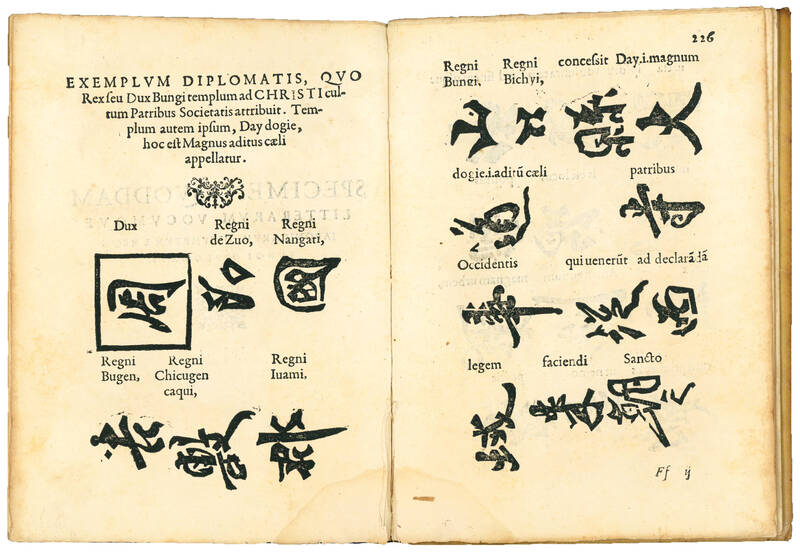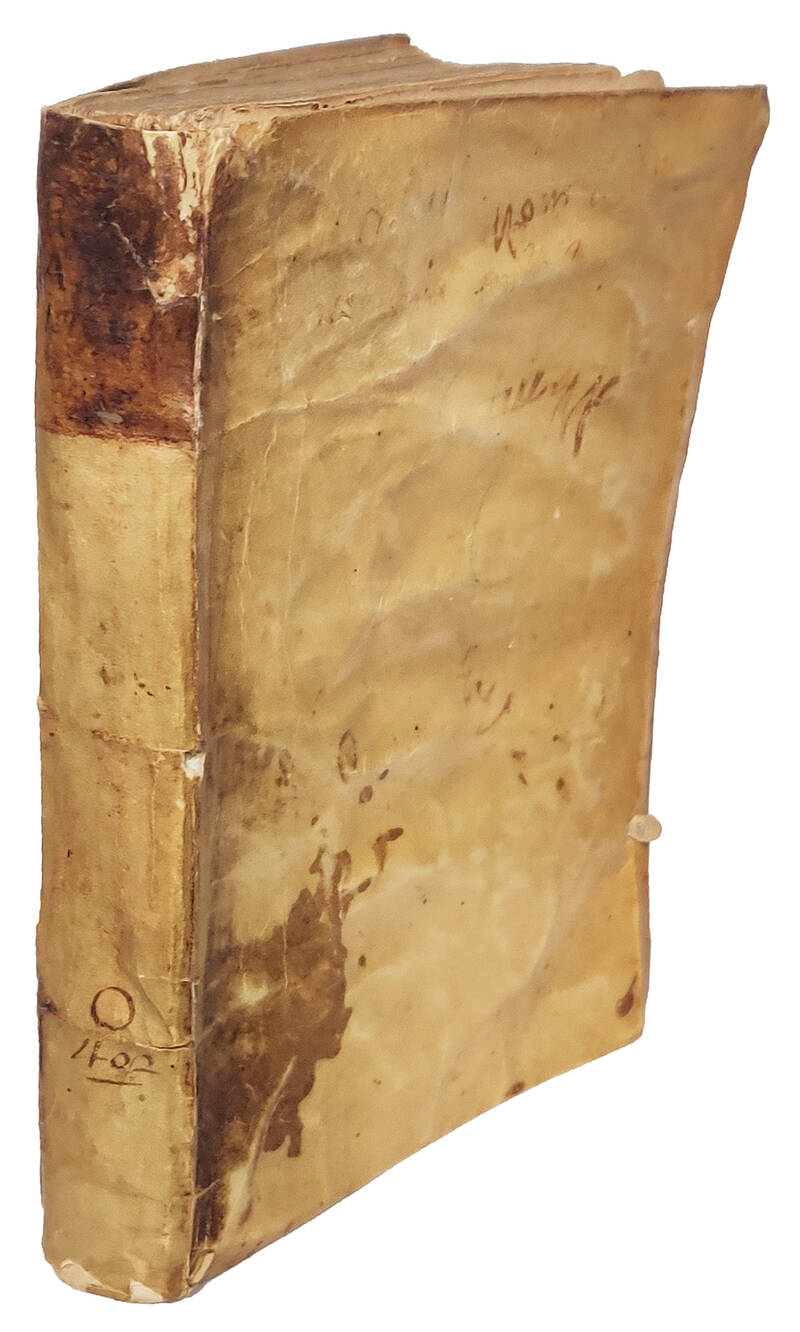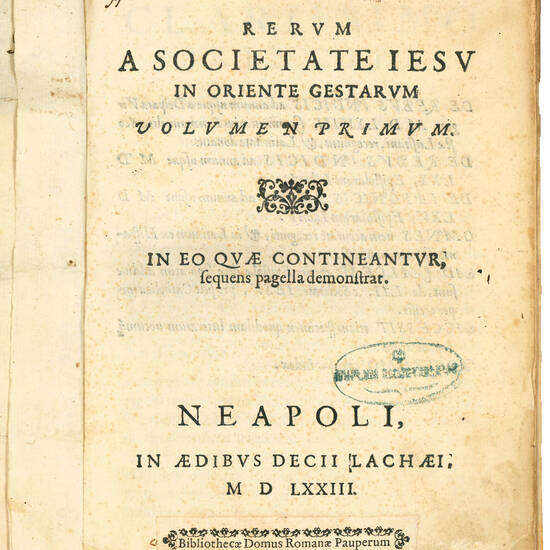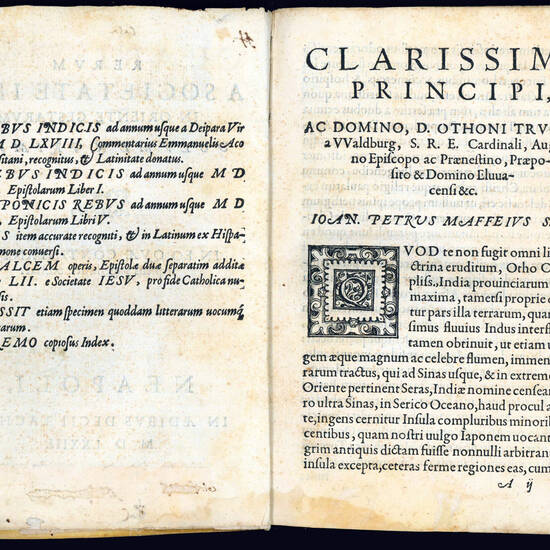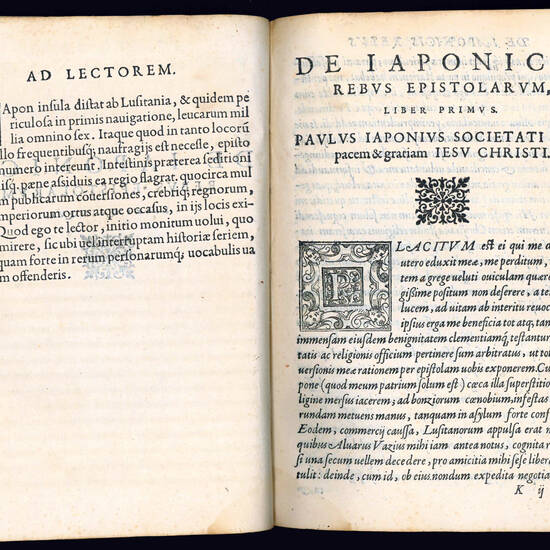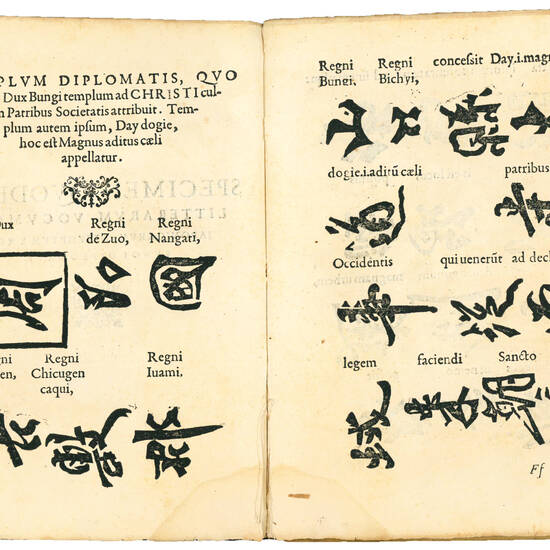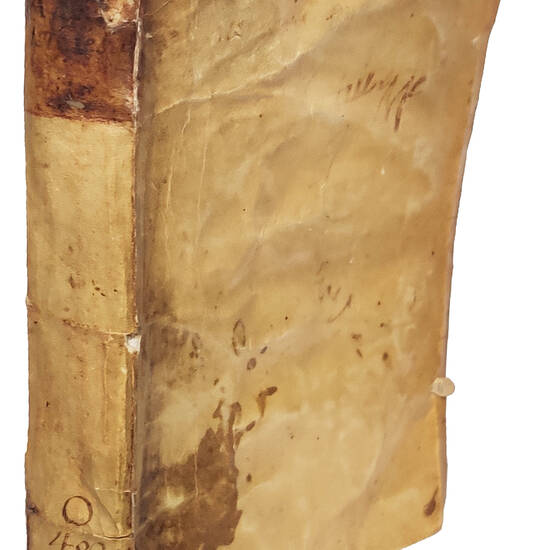“THE FIRST ATTEMPT AT AN OFFICIAL HISTORY OF THE MISSION IN ASIA” (FAVI) - ONE OF THE FIRST APPEARANCES OF JAPANESE IDEOGRAMS IN EUROPE
4to (200x145 mm). 236, [2] leaves. Collation: A-Ee8 Ff4 Gg8 Hh2. Roman and italic types. Woodcut decorative initials. It contains: De rebus Indicis commentarius (l. A4r), De rebus Indicis epistolarum liber (l. E6v), De Iaponicis rebus epistolarum libri quinque (l. K1r), Specimen quoddam litterarum vocumque Iaponicarum; desumptum e regis Bungi diplomate (l. Ff1, with samples of Japanese ideograms), De quinquaginta duobus a Societate Iesu, pro fide Catholica nuper occisis, epistolae duae (l. Gg1r), Index epistolarum and Index rerum memorabilium (l. Hh1r). Contemporary flexible vellum with inked title and shelf mark on spine (stained, traces of ties). On the front pastedown old manuscript shelf mark and stamp of the “Libreria Samonati, Roma”; on the title page faded stamp and 17th-century bookplate “Bibliothecae Domus Romanae Pauperum Matris Dei Scholarum Piarum”, covering an erased ownership entry. Small restoration to the bottom of the title page, small tear to the lower margin of l. G7 with no loss, small hole to the bottom outer corner of l. Cc7 not affecting the text, some browning and foxing, pale water stain to the lower margin of most of the volume, all in all a good, genuine copy.
Third, enlarged, and best edition of the first official Jesuit history of the eastern missions, in the issue bearing Decio Lachei as printer. There are copies of this edition with same collation and fingerprint but having a different title page (Rerum a Societate Iesu in Oriente gestarum volumen. In quo hæc ferme continentur. De rebus Indicis ad annum vsque a Deipara Virgine 1568, commentarius Emmanuelis Acostæ Lusitani, recognitus, & Latinitate donatus), indicating Orazio Salviani as printer.
This edition preserves the original dedication (dated from Rome, 17 November 1570) by the editor Giovanni Pietro Maffei to Cardinal Otto Truchsess von Walburg (1514-1573), former Prince-Bishop of Augsburg and founder of the university of Dillingen, who resided in Rome from 1568 to his death. The name of Manuel da Costa appears in the index of content at the title-page verso.
In the first 1571 Dillingen edition this collection comprised only Acosta's commentary and thirty-nine letters from Japan, covering the years 1548 to 1564 and arranged chronologically in four books. The second edition (Paris, 1572) added an unnumbered book with letters from India, the East Indies and Southeast Asia in the years 1568 to 1570, and the first of the two letters concerning Brazil that appears in this third edition as an appendix, i.e., the one written from Madera in 1570. The present third edition is the most complete as it added for the first time a fifth book of letters from Japan written in 1565; the Specimen with printed samples of Japanese characters reproducing a letter by the daimyo of Bungo, Otomo Sorin (to be exact: Ouchi Yoshitaka, daimyo of Yamaguchi), permitting the Jesuits to build a church on his land in the province of Yamaguchi; and the second of the two final letters concerning Brazil, the one written from Lisbon in 1571 about the martyr of Ignacio de Azevedo (1528-1570), who had worked for three years at a mission in Brazil and was killed in the Canary Islands. Apparently no further letters were added in the following 1574 and 1583 editions.
This collection represents the first official attempt to write a detailed history of the Jesuit missions, especially in the Far East, offering a synthesis of letters sent by the missionaries from the missions in order to chronicle their successes and failures. Acosta's commentary was first written in Portuguese (Historia dos missiones do Oriente até o anno de 1568). The manuscript of the work was then sent to Rome, where it was translated into Latin and edited by the young novice Giovanni Pietro Maffei. Maffei is also responsible for the addition of what is in fact the overwhelming bulk of the collection, i.e. the De Japonicis rebus epistolarum, containing abridged Latin translations of letters sent from the Jesuit fathers working in Japan like Luis Frois (1532-1597), Gaspar Vilela (1525-1572), and Luis de Almeida (1525-1583), only to mention a few. The letters begin with the Japanese convert Paul's letter from Goa written in December 1548, followed by two famous letters of St. Francis Xavier published in this collection for the first time: the first of these is written from Malacca in June 1549, the second on his arrival in Japan from Kagoshima in November 1549.
Edit 16, CNCE13631; H. Cordier, Bibliotheca Japonica, Hildesheim, 1969, col. 59; A. & A. De Backer-C. Sommervogel, Bibliothèque de la Compagnie de Jésus, Bruxelles-Paris, 1894, V, coll. 294-295; A. Palau, Manuel del librero hispanoamericano, no. 146953; S. Favi, Self Through the Other: Production, Circulation and Reception in Italy of Sixteenth-Century Printed Sources on Japan, Venice, 2018, p. 123.
[12713]

